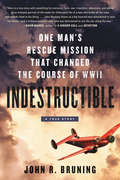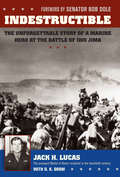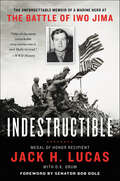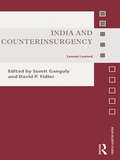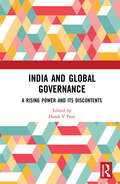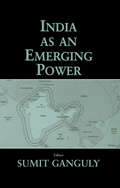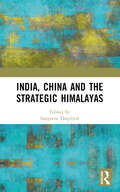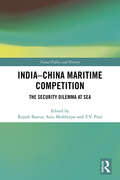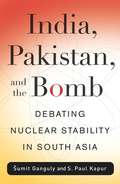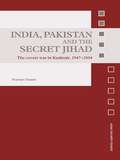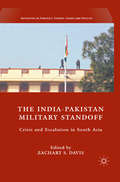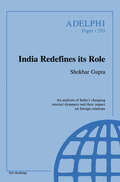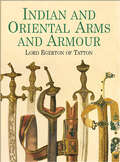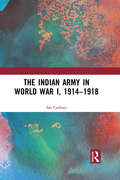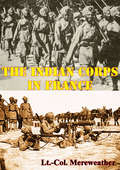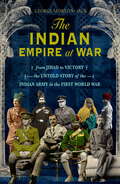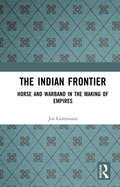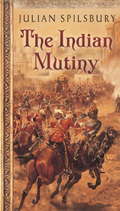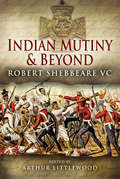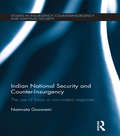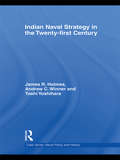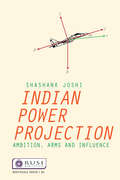- Table View
- List View
Indestructible: One Man's Rescue Mission That Changed the Course of WWII
by John R BruningIn this remarkable WWII story by New York Times bestselling author John R. Bruning, a renegade American pilot fights against all odds to rescue his family--imprisoned by the Japanese--and revolutionizes modern warfare along the way.From the knife fights and smuggling runs of his youth to his fiery days as a pioneering naval aviator, Paul Irving "Pappy" Gunn played by his own set of rules and always survived on his wits and fists. But when he fell for a conservative Southern belle, her love transformed him from a wild and reckless airman to a cunning entrepreneur whose homespun engineering brilliance helped launch one of the first airlines in Asia.Pappy was drafted into MacArthur's air force when war came to the Philippines; and while he carried out a top-secret mission to Australia, the Japanese seized his family. Separated from his beloved wife, Polly, and their four children, Pappy reverted to his lawless ways. He carried out rescue missions with an almost suicidal desperation. Even after he was shot down twice and forced to withdraw to Australia, he waged a one-man war against his many enemies--including the American high command and the Japanese--and fought to return to the Philippines to find his family.Without adequate planes, supplies, or tactics, the U.S. Army Air Force suffered crushing defeats by the Japanese in the Pacific. Over the course of his three-year quest to find his family, Pappy became the renegade who changed all that. With a brace of pistols and small band of loyal fol,lowers, he robbed supply dumps, stole aircraft, invented new weapons, and modified bombers to hit harder, fly farther, and deliver more destruction than anything yet seen in the air. When Pappy's modified planes were finally unleashed during the Battle of the Bismarck Sea, the United States scored one of the most decisive victories of World War II. Taking readers from the blistering skies of the Pacific to the jungles of New Guinea and the Philippines to one of the the war's most notorious prison camps, Indestructible traces one man's bare-knuckle journey to free the people he loved and the aerial revolution he sparked that continues to resonate across America's modern battlefields.
Indestructible: The Unforgettable Story of a Marine Hero at Iwo Jima
by Jack Lucas D. K. DrumDuring the battle of Iwo Jima, two enemy grenades landed close to Jack Lucas and his buddies. Jack threw himself on one of the grenades, grabbed the second, and pulled it beneath his body. His buddies were saved, but Lucas was badly injured. Miraculously, he survived-but just barely. For this brave action seventeen-year-old Jack Lucas from North Carolina became the youngest Marine in history to receive the Medal of Honor. Indestructible reveals the rocky road that led Jack Lucas to Iwo Jima, his arduous recovery, and the obstacles Jack overcame later in life. Jack’s moving and powerful memoir is a testament to America’s greatest generation.
Indestructible: The Unforgettable Memoir of a Marine Hero at the Battle of Iwo Jima
by Jack H. Lucas D. K. DrumMedal of Honor recipient Jack H. Lucas’s classic memoir of his heroics at the Battle of Iwo Jima—with a foreword by Bob Dole and reissued to coincide with the 75th anniversary of the battle in 2020.On February 20, 1945, the second day of the assault on Iwo Jima—one of the bloodiest battles of the Pacific theater in World War II—Private Jack Lucas, who was only seventeen, and three other Marines engaged in a close-proximity firefight with Japanese soldiers. When two enemy grenades landed in their trench, Lucas jumped on one and pulled the other under his body to save the lives of his comrades. Lucas was blown into the air as his body was torn apart by 250 entrance wounds. He was so severely wounded that his team left him for dead. Miraculously, he survived.While on the hospital ship Samaritan, his spirit soared to see the American flag flying atop Mount Suribachi—the same flag immortalized in Joe Rosenthal’s iconic photograph, Raising the Flag on Iwo Jima. Lucas endured twenty-one grueling surgeries and carried 200 pieces of shrapnel in his body for the rest of his life. Awarded the Medal of Honor, he became the youngest Marine in U.S. history—and the youngest of all World War II servicemen—to receive the honor.Indestructible tells the remarkable story of an extraordinary American possessed with a fierce determination to serve his country.
India and Counterinsurgency: Lessons Learned (Asian Security Studies)
by Sumit Ganguly David P. FidlerThis edited volume focuses on India's experiences waging counterinsurgency campaigns since its independence in 1947. Filling a clear gap in the literature, the book traces and assess the origins, evolution and current state of India's counterinsurgency strategies and capabilities, focusing on key counterinsurgency campaigns waged by India within and outside its territory. It also analyzes the development of Indian doctrine on counterinsurgency, and locates this within the overall ebb and flow of India's defense and security policies. The central argument is that counterinsurgency has been an integral part of India's overall security policy and can thereby impart much to political and military leaders in other states. Since its emergence from British colonialism, India's defence policies have not merely sought to protect and preserve India's inherited colonial borders from threats by rival states, but have also sought to prevent and suppress secessionist movements. In countering insurgencies, the Indian state has fashioned strategies that seek to repress militarily any secessionist movement, while simultaneously forging a range of civilian administrative and institutional arrangements that attempt to address the grievances of disaffected populations. The book highlights key strategic and tactical innovations that the Indian Army and security forces made to deal with a range of insurgent movements. Simultaneously, it also examines how the civilian-military nexus enabled India's policy makers to utilize existing, and formulate novel, institutional means to address extant political grievances. India has been most successful where it has managed to use calibrated force, obtained the trust of much of the aggrieved population and made persuasive commitments to political and institutional reform. Examination of these elements of India's counterinsurgency performance can be compared to counterinsurgency doctrine developed by other countries, including the United States, and thus yield comparative policy prescriptions and recommendations that can be applied to other counterinsurgency contexts. This book will be of great interest to students of counterinsurgency and irregular warfare, Indian politics, Asian Security Studies and Strategic Studies in general.
India and Global Governance: A Rising Power and Its Discontents
by Harsh V PantThis volume explores India’s role in the global governance architecture post–Cold War. It shows how, with a rise in India’s capabilities, there is an expectation from its external interlocutors that New Delhi ought to play a larger global role. As Indian policymakers redefine their engagements in the global policy matrix, the chapters in the volume analyse India’s role as a challenger and a stakeholder in world politics; its uneasy relationship with Western liberal democracies; and its role in shaping new structures of global governance. The volume focuses on a host of critical issues, including nuclear policy, climate action politics, India’s bid for a permanent seat at the UN Security Council, humanitarian interventions, trade governance, democracy promotion, India’s engagement with other emerging powers in platforms such as the BRICS, the changing dynamics with its neighbours, and maritime governance. A timely reimagining of global politics, this book will be of great interest to scholars and researchers of politics and international relations, climate change, military and strategic studies, economics, and South Asian studies.
India as an Emerging Power
by Sumit GangulyThese essays examine India's relations with key powers including the Russian Federation, China and the USA and with key adversaries in the global arena in the aftermath of the Cold War. One positive relationship is that of India's relations with Israel since 1992.
India, China and the Strategic Himalayas
by Sangeeta ThapliyalThis book analyses strategic discourse on the Himalayas from the perspective of India’s interests. Home to many communities, cultures, natural resources and political boundaries, it is the geopolitical landscape of the Himalayas between India and China that dominates other narratives and discourses. The traditional notion of Himalayas as India’s frontiers and buffer is challenged by China. Despite various mechanisms to address border resolution there are violations and transgressions from China. This book examines India’s responses to the new emerging challenges in the Himalayas. How the statist discourse on strategic interests incorporates people’s discourse. It provides a nuanced understanding of India’s strategic undertakings, diplomatic initiatives and development framework. This book will be a valuable addition to existing knowledge on the Himalayas between India and China. Scholars and practitioners interested in International Relations, Strategic Studies, Himalayan Studies and South Asian Studies will find it useful. Print edition not for sale in South Asia (India, Sri Lanka, Nepal, Bangladesh, Pakistan and Bhutan)
India-China Maritime Competition: The Security Dilemma at Sea (Cass Series: Naval Policy and History)
by Rajesh Basrur Anit Mukherjee T. V. PaulThis edited volume critically examines the concept of the “security dilemma” and applies it to India–China maritime competition. Though frequently employed in academic discussion and popular commentary on the Sino-Indian relationship, the term has rarely been critically analysed. The volume addresses the gap by examining whether the security dilemma is a useful concept in explaining the naval and foreign policy strategies of India and China. China’s Belt and Road Initiative and its expansive engagement in the Indian Ocean Region have resulted in India significantly scaling up investment in its navy, adding ships, naval aircraft and submarines. This volume investigates how the rivalry is playing out in different sub-regions of the Indian Ocean, and the responses of other powers, notably the United States and prominent Southeast Asian states. Their reactions to the Sino-Indian rivalry are an underexplored topic and the chapters in this book reveal how they selectively use that rivalry while trying to steer clear of making definite choices. The book concludes with recommendations on mitigating the security dilemma. This work will be of great interest to students of strategic studies, international relations, maritime security, and Asian politics.
India, Pakistan, and the Bomb: Debating Nuclear Stability in South Asia
by Ganguly Umit S. Paul KapurIn May 1998, India and Pakistan put to rest years of speculation as to whether they possessed nuclear technology and openly tested their weapons. Some believed nuclearization would stabilize South Asia; others prophesized disaster. Authors of two of the most comprehensive books on South Asia's new nuclear era, Sumit Ganguly and S. Paul Kapur, offer competing theories on the transformation of the region and what these patterns mean for the world's next proliferators. Ganguly begins with an outcome-based approach emphasizing the results of militarized conflict. In his opinion, nuclear weapons have prevented Indo-Pakistani disputes from blossoming into full-scale war. Kapur counters with a process-based approach stressing the specific pathways that lead to conflict and escalation. From his perspective, nuclear weapons have fueled a violent cycle of Pakistani provocation and Indian response, giving rise to a number of crises that might easily have spun into chaos. Kapur thus believes nuclear weapons have been a destabilizing force in South Asia and could similarly affect other parts of the world. With these two major interpretations, Ganguly and Kapur tackle all sides of an urgent issue that has profound regional and global consequences. Sure to spark discussion and debate, India, Pakistan, and the Bomb thoroughly maps the potential impact of nuclear proliferation.
India, Pakistan and the Secret Jihad: The Covert War in Kashmir, 1947-2004 (Asian Security Studies)
by Praveen SwamiIndia, Pakistan and the Secret Jihad explores the history of jihadist violence in Kashmir, and argues that the violent conflict which exploded after 1990 was not a historical discontinuity, but, rather, an escalation of what was by then a five-decade old secret war. Praveen Swami addresses three key issues: the history of jihadist violence in Jammu and Kashmir, which is examined as it evolved from 1947-48 onwards the impact of the secret jihad on Indian policy-making on Jammu and Kashmir, and its influence on political life within the state why the jihad in Jammu and Kashmir acquired such intensity in 1990. This new work will be of much interest to students of the India-Pakistan conflict, South Asian politics and security studies in general.
The India-Pakistan Military Standoff
by Zachary S. DavisThis book focuses on the 2001-2002 crisis that brought India and Pakistan to the brink of war. Authors focus on: the political history that led to the crisis; the conventional military environment, the nuclear environment and coercive diplomacy and de-escalation during the crisis; and how South Asia can avoid similar crises in the future.
India Redefines its Role (Adelphi series #293)
by Shekhar GuptaFirst Published in 2005. Routledge is an imprint of Taylor & Francis, an informa company.
Indian and Oriental Arms and Armour (Dover Military History, Weapons, Armor)
by Lord Egerton of TattonOriginally created in the late 19th century to catalog Indian and Oriental arms and armor for a British museum, this volume has long since become a sourcebook of vital information on the military history of India. Enhanced with excellent illustrations, it remains one of the few books available on the subject, providing factual accounts of events ranging from the earliest invasions of the subcontinent in 200 B.C. to the decline of the Mogul Empire (early 18th century) and the First Burmese War in 1824. In addition to information on military history, succeeding chapters describe Indian swords, helmets, knives, shields, daggers, spears, javelins, blowpipes, sabers, and a host of other weapons, including arms used for athletic and sacrificial purposes. Descriptive notes, grouped according to geographical areas, comment on styles of decoration, manufacturing processes, and ethnological characteristics. A shorter section of the book includes detailed information on Arab and Persian arms (maces, battle axes, matchlock guns, bows and arrows, etc.) and Japanese armor. Students of Far Eastern arms and armor as well as enthusiasts of military history will welcome this comprehensive reference. 350 halftones and line illustrations. 350 halftones and line illustrations.
The Indian Army and the End of the Raj
by Daniel MarstonThe Partition of British India in 1947 resulted in the establishment of the independent states of India and Pakistan and the end of the British Raj. The decision to divide British India along religious lines led to widespread upheaval and communal violence in the period leading up to and following the official day of independence, 15 August 1947. In this book, Daniel Marston provides a unique examination of the role of the Indian army in post-World War II India. He draws upon extensive research into primary source documents and interviews with veterans of the events of 1947 to provide fresh insight into the vital part that the Indian Army played in preserving law and order in the region. This rigorous book fills a significant gap in the historiography of the British in India and will be invaluable to those studying the British Empire and South Asia more generally.
The Indian Army in World War I, 1914-1918
by Ian CardozoThis volume recounts India’s contribution to World War I. Please note: Taylor & Francis does not sell or distribute the Hardback in India, Pakistan, Nepal, Bhutan, Bangladesh and Sri Lanka
The Indian Army on the Western Front
by George Morton-JackThe Indian army fought on the Western Front with the British Expeditionary Force (BEF) from 1914 to 1918. Traditional interpretations of its performance have been dominated by ideas that it was a failure. This book offers a radical reconsideration by revealing new answers to the questions that have been central to the debate, such as whether the Indian army 'saved' the BEF from defeat in 1914, or whether Indian troops were particularly prone to self-inflict wounds and to flee the trenches. It looks at the Indian army from top to bottom, from generals at headquarters to snipers in no man's land. It takes a global approach, exploring the links between the Indian army's 1914-18 campaigning in France and Belgium and its pre-1914 small wars in Asia and Africa, and comparing the performance of the Indian regiments on the Western Front to those in China, east Africa, Mesopotamia, Gallipoli and elsewhere.
The Indian Corps In France [Illustrated Edition]
by Lt.-Col. John Walter Beresford Merewether Frederick Edwin Smith Earl of BirkenheadIncludes 24 portraits, maps and plans."The only history of the Indian Corps in France in the Great War, from 1914 to 1915 when the Corps transferred to the Middle East. A fascinating story.The Indian Corps, consisting of two infantry divisions (Meerut and Lahore), arrived in France in September/October 1914. It was commanded by Lieutenant-General Sir James Willcocks who was the most senior officer in the BEF after Field Marshal Sir John French and General Sir Horace Smith-Dorrien. The corps remained on the Western Front till the end of 1915, when it was transferred to the Middle East, a more suitable theatre of war for Indian Army troops. This history was published at the request and under the authority of the India Office, and apart from General Willcocks' own memoirs, With The Indians in France, it is the only record of the corps. It is not altogether a happy tale, as the book makes clear. While there was no questioning the bravery of the troops (five Indian/Gurkha VCs) there were problems of climate, reinforcements, officer casualties (the Indian battalion had only 13 British officers, who were first priority targets for the Germans), not to mention mishandling and lack of understanding on the part of the High Command. Total casualties among Indian Army units amounted to 21,413 (each division had, initially, three British battalions and divisional artillery was British). An unusual and fascinating story and history."-Print Ed.
The Indian Empire At War: From Jihad to Victory, The Untold Story of the Indian Army in the First World War
by George Morton-Jack'Essential to a proper understanding of the war and of our world of today' Michael Morpurgo1.5 million Indians fought with the British in the First World War - from Flanders to the African bush and the deserts of the Islamic world, they saved the Allies from defeat in 1914 and were vital to global victory in 1918. Using previously unpublished veteran interviews, this is their story, told as never before.
The Indian Frontier: Horse and Warband in the Making of Empires
by Jos GommansThis omnibus brings together some old and some recent works by Jos Gommans on the warhorse and its impact on medieval and early modern state-formation in South Asia. These studies are based on Gommans’ observation that Indian empires always had to deal with a highly dynamic inner frontier between semi-arid wilderness and settled agriculture. Such inner frontiers could only be bridged by the ongoing movements of Turkish, Afghan, Rajput and other warbands. Like the most spectacular examples of the Delhi Sultanate and the Mughal Empires, they all based their power on the exploitation of the most lethal weapon of that time: the warhorse. In discussing the breeding and trading of horses and their role in medieval and early modern South Asian warfare, Gommans also makes some thought-provoking comparisons with Europe and the Middle East. Since the Indian frontier is part of the much larger Eurasian Arid Zone that links the Indian subcontinent to West, Central and East Asia, the final essay explores the connected and entangled history of the Turko-Mongolian warband in the Ottoman and Timurid Empires, Russia and China.
The Indian Mutiny
by Julian SpilsburyAn epic true story of treachery, revenge and courageThe Indian Mutiny is a real page-turner, an epic story with surprising modern parallels. Fomer army officer-turned-TV scriptwriter, Julian Spilsbury is the ideal author to take us back to the desperate summer of 1857 when thousands of Indian soldiers mutinied. They murdered their officers, hunted down the women and children and burned and slaughtered their way to Delhi. The tiny British garrison at Lucknow held out against all odds; the one at Cawnpore surrendered only to be betrayed and massacred.Modern Indian accounts call this 'the first war of liberation', but as Julian Spilsbury reveals, 80 per cent of the so-called 'British' forces were from the sub-continent. Sikhs, Gurkhas and Afghans fought alongside small numbers of British soldiers. Together, they faced terrible odds and won. In the process they created a new army that would play a vital role in the Allied forces in both World Wars. Julian Spilsbury weaves the story together from some of the most vivid eyewitness accounts ever written. From the women and children hiding from blood-crazed mobs, to the epic battles that decided the campaign, to the grisly revenge exacted by the British forces, this is a gripping recreation of the greatest crisis of Empire.
The Indian Mutiny
by Julian SpilsburyAn epic true story of treachery, revenge and courageThe Indian Mutiny is a real page-turner, an epic story with surprising modern parallels. Fomer army officer-turned-TV scriptwriter, Julian Spilsbury is the ideal author to take us back to the desperate summer of 1857 when thousands of Indian soldiers mutinied. They murdered their officers, hunted down the women and children and burned and slaughtered their way to Delhi. The tiny British garrison at Lucknow held out against all odds; the one at Cawnpore surrendered only to be betrayed and massacred.Modern Indian accounts call this 'the first war of liberation', but as Julian Spilsbury reveals, 80 per cent of the so-called 'British' forces were from the sub-continent. Sikhs, Gurkhas and Afghans fought alongside small numbers of British soldiers. Together, they faced terrible odds and won. In the process they created a new army that would play a vital role in the Allied forces in both World Wars. Julian Spilsbury weaves the story together from some of the most vivid eyewitness accounts ever written. From the women and children hiding from blood-crazed mobs, to the epic battles that decided the campaign, to the grisly revenge exacted by the British forces, this is a gripping recreation of the greatest crisis of Empire.
Indian Mutiny and Beyond: Robert Shebbeare VC
by Arthur Littlewood"Robert Shebbeare went out as a cadet to India at the age of seventeen and after a spell of ordinary regimental duties, he was caught up in the extraordinary and bloody events of the Indian Mutiny.With fellow officers he managed to escape to Delhi, where he was attached to the Guides, and he took part in most of the action during the long hot summer of 1857. He was wounded six times and was awarded the Victoria Cross for his gallantry during the storming of the city on September 14th. He raised a new regiment, the 15th Punjab, which volunteered for service in China and took part in the advance on Peking in 1860.Tragically, he died en route for England, his family, who had not seen him since he had left 16 years earlier, were all at the quayside to welcome him, unaware that he had been buried at sea.His story is told in his own words from the recently discovered letters which he sent home to his family between 1844–1860. The Editor has provided a commentary that puts the letters into context for the general reader and military historians. "
Indian National Security and Counter-Insurgency: The use of force vs non-violent response (Studies in Insurgency, Counterinsurgency and National Security)
by Namrata GoswamiThis book, based on extensive field research, examines the Indian state’s response to the multiple insurgencies that have occurred since independence in 1947. In reacting to these various insurgencies, the Indian state has employed a combined approach of force, dialogue, accommodation of ethnic and minority aspirations and, overtime, the state has established a tradition of negotiation with armed ethnic groups in order to bolster its legitimacy based on an accommodative posture. While these efforts have succeeded in resolving the Mizo insurgency, it has only incited levels of violence with regard to others. Within this backdrop of ongoing Indian counter-insurgency, this study provides a set of conditions responsible for the groundswell of insurgencies in India, and some recommendations to better formulate India’s national security policy with regard to its counter-insurgency responses. The study focuses on the national institutions responsible for formulating India’s national security policy dealing with counter-insurgency – such as the Prime Minister’s Office, the Cabinet Committee on Security, the National Security Council, the Ministry of Home Affairs and the Indian military apparatus. Furthermore, it studies how national interests and values influence the formulation of this policy; and the overall success and/or failure of the policy to deal with armed insurgent movements. Notably, the study traces the ideational influence of Kautilya and Gandhi in India’s overall response to insurgencies. Multiple cases of armed ethnic insurgencies in Assam, Manipur, Mizoram, and Nagaland in the Northeast of India and the ideologically oriented Maoist or Naxalite insurgency affecting the heartland of India are analysed in-depth to evaluate the Indian counter-insurgency experience. This book will be of much interest to students of counter-insurgency, Asian politics, ethnic conflict, and security studies in general.
Indian Naval Strategy in the Twenty-first Century (Cass Series: Naval Policy and History)
by James R. Holmes Andrew C. Winner Toshi YoshiharaThis is the first academic study of India's emerging maritime strategy, and offers a systematic analysis of the interplay between Western military thought and Indian maritime traditions. By a quirk of historical fate, Europe embarked on its Age of Discovery just as the main Asian powers were renouncing the sea, ushering in centuries of Western dominance. In the 21st century, however, Asian states are once again resuming a naval focus, with both China and India dedicating some of their new-found wealth to building powerful navies and coast guards, and drawing up maritime strategies to govern the use of these forces. The United States, like the British Empire before it, is attempting to manage these rising sea powers while preserving its maritime primacy. This book probes how India looks at the sea, what kind of strategy and seagoing forces New Delhi may craft in the coming years, and how Indian leaders may use these forces. It examines the material dimension, but its major premise is that navies represent a physical expression of a society's history, philosophical traditions, and culture. This book, then, ventures a comprehensive appraisal of Indian maritime strategy. This book will be of interest to students of sea power, strategic studies, Indian politics and Asian Studies in general. James R. Holmes is an Associate Professor of Strategy at the U.S. Naval War College and a former U.S. Navy surface warfare officer. Toshi Yoshihara is an Associate Professor in the Strategy and Policy Department at the Naval War College. Andrew C. Winner is Professor in the Strategic Research Department at the U.S. Naval War College.
Indian Power Projection: Ambition, Arms and Influence (Whitehall Papers)
by Shashank JoshiIndia is growing into one of Asia’s most important military powers. Its defence budget has more than doubled in the past decade, and it imports more arms than anyone else in the world. But India is still seen as a land power focused on long, disputed and militarised borders with Pakistan and China rather than the global military force it was in the first half of the twentieth century under British rule. Is this changing? India is acquiring increasing numbers of key platforms – aircraft carriers, amphibious ships, refuelling tankers and transport aircraft – that are extending its reach to the Indian Ocean littoral and beyond. But most accounts of this build-up have been impressionistic and partial. Indian Power Projection assesses the strength, reach and purposes of India's maturing capabilities. It offers a systematic assessment of India’s ability to conduct long-range airstrikes from land and sea, transport and convey airborne and amphibious forces, and develop the institutional and material enablers that turn platforms into capabilities. It draws extensively on the lessons of modern expeditionary operations, and considers how India’s growing interests might shape where and how it uses these evolving capabilities in the future. This study finds that Indian power projection is in a nascent stage: limited in number, primarily of use against much-weaker adversaries, and deficient in some key supporting capabilities. India’s defence posture will continue to be shaped by local threats, rather than distant interests. Indian leaders remain uncomfortable with talk of military intervention and expeditionary warfare, associating these with colonial and superpower excess. But as the country’s power, interests and capabilities all grow, it is likely that India will once more find itself using military force beyond its land borders.
